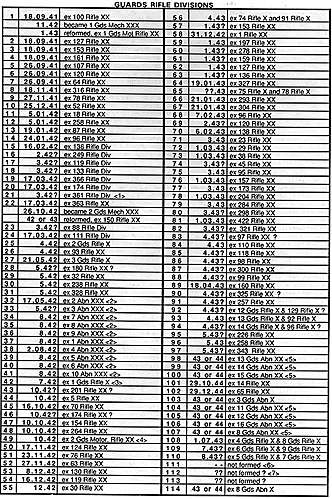 GUARDS RIFLE DIVISIONS
GUARDS RIFLE DIVISIONS
Rifle divisions were the backbone of the Red Army, providing the infantry with the power to take and hold ground. Similar to other nations' infantry divisions, they were called "rifle" divisions for propaganda purposes dating back to the Russian Revolution and Civil War. In the old Russian army, an infantry unit was an average formation, while a rifle unit was supposed to be a crack infantry formation. The Bolsheviks adopted "rifle" for all their infantry forces to imply the superiority of communist troops over imperialist forces.
At least 117 Guards rifle divisions were formed during the war against Germany, numbering consecutively from 1 to 110 and then non- consecutively up to 129. Most were formed from regular rifle divisions, but any infantry forces could become Guards rifles. (Various airborne corps, Guards airborne divisions, airborne brigades, and rifle brigades all became Guards rifle divisions during the war. Scorched Earth shows only rifle divisions directly becoming Guards.
When a different formation became a Guards rifle division, SE places the Guards division in the replacement pool and assumes it will be raised via replacements or via disbanding other units.)
Rifle divisions underwent many reorganizations during the war, but always consisted of a core of three rifle regiments, one artillery regiment, and various support units.
Jumbo Rifle Division Chart (very slow: 270K)
Rifle Division Notes:
1) Since 19, 20 and 22 Gds Rifle XX were formed on 17 March 1943, it's ve ry probable that 21 was also formed on the same day, even though direct confirmation is lacking. This reasoning can be applied throughout the list for dates between two definite dates, except for the divisions numbered above 97.
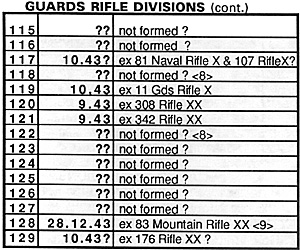 2) An airborne corps was a small
formation, about the size of a division,
consisting of three airborne brigades.
Thus, converting an entire corps to a
Guards division made sense. The
original five airborne corps had proven
to be excellent forces during 1941, and
in the winter of 1941/42 the Soviets
began replacing their shattered first five
corps and forming five new corps. As
these became combat-ready, they
were designated Guards rifle divisions
and sent to the Stalingrad area. In
Scorched Earth, the original airborne
corps (shown at brigade level) are
considered eliminated in combat in the
1941 and winter 1941/42 fighting, with
ten airborne corps being formed new in
1942. Rather than show them as corps
only to immediately convert them to
Guards divisions, these units appear
directly as Guards reinforcements.
2) An airborne corps was a small
formation, about the size of a division,
consisting of three airborne brigades.
Thus, converting an entire corps to a
Guards division made sense. The
original five airborne corps had proven
to be excellent forces during 1941, and
in the winter of 1941/42 the Soviets
began replacing their shattered first five
corps and forming five new corps. As
these became combat-ready, they
were designated Guards rifle divisions
and sent to the Stalingrad area. In
Scorched Earth, the original airborne
corps (shown at brigade level) are
considered eliminated in combat in the
1941 and winter 1941/42 fighting, with
ten airborne corps being formed new in
1942. Rather than show them as corps
only to immediately convert them to
Guards divisions, these units appear
directly as Guards reinforcements.
3) The 42nd apparently was formed before some of the lower-numbered divisions.
4) See the Guards motorized rifle divisions listing for more information on 2 Gds Mot Rifle XX.
5) After producing a wave of ten airborne corps that became Guards rifle divisions (see <2> above), the airborne schools immediately began producing another wave of airborne corps and maneuver airborne brigades, which became ten Guards airborne divisions, 1-10 (see the Guards airborne divisions listing). A second wave of six divisions, 11-16, had a more shadowy existence. Supposedly formed in June 1943, these units simply never appear until they are redesignated Guards rifle divisions in 12.43 or 1.44 and then sent off for the 1944 fighting. In Scorched Earth, these units are shown directly as Guards rifle divisions and appear in the replacement pool in June 1943, for the Soviet player to raise however he can. It's still an open question if this is best or if it would be better to have them appear as reinforcements in January 1944.
6) Since Soviet sources state that Guards divisions were formed consecutively 1-110 and then non- consecutively up to 129, it sure seems likely there was no 111 Gds Rifle XX Other divisions listed as "not formed ?" are guesses based on lack of evidence of their existence. All "not formed" Guards divisions are placed in the replacement pool in Scorched Earth. This allows for the possibility of their being raised should the Soviet player find sufficient resources, similar to the Germans having the potential to raise the 27th Panzer Division.
7) Scorched Earth shows the 112th as a Guards airborne division, based on German intelligence - there is no Soviet mention of a 112th Guards, airborne or otherwise. I'm coming to believe that this was a mistaken identification, and I'll probably be deleting the 112th from the game unless better evidence soon shows up.
8) One Soviet newspaper from June 1945 claims the 7 and 249 Rifle XX's respectively became the 118 and 122 Gds Rifle XX's, but it's unclear if they became Guards in June (post VE Day) or earlier. No other source mentions this.
9) 128 Gds is a mountain unit in Scorched Earth.
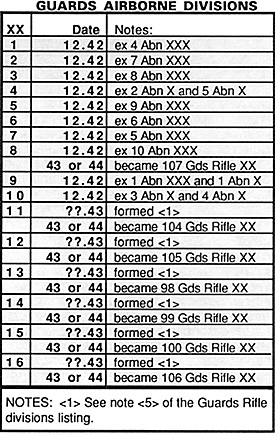 AIRBORNE DIVISIONS
AIRBORNE DIVISIONS
Soviet airborne forces, like most airborne forces, were tough, hardfighting outfits. Similar to the mid/late war Luftwaffe parachute divisions, the Soviet airborne forces were crack ground troops rather than air-drop capable forces. Many airborne units became Guards rifle divisions, as explained in notes 2 and 5 in the Guards rifle divisions notes. One wave of ten Guards airborne divisions was formed in late 1942 from new airborne corps and brigades. Organized around three airborne rifle regiments and one artillery regiment, the divisions fought on the ground with distinction to the end of the war.
MOTORIZED RIFLE DIVISIONS
By the start of the war, the Soviets had two different types of motor- transported divisions: a motorized division (for the 1940/ 41 mechanized corps) built around two motorized rifle regiments, a tank regiment, and an artillery regiment; and a motorized rifle division (for independent operations) built around three motorized rifle regiments, a tank battalion, and an artillery regiment. In theory, both were powerful formations (the motorized division on paper had more tanks than a German Panzer division!), but the lack of equipment, trained specialists, and experienced officers rendered most of these divisions of little use. Sustaining high losses in the summer of 1941, almost all of these divisions lost their vehicles and became rifle divisions. Three fought with particular distinction and became Guards motorized rifle divisions.
Not much is known about the organization or exploits or the Guards motorized divisions during 1942. Presumably they were based on a version of the 1941 motorized rifle division organization, but their degree of actual motorization isn't known (Scorched Earth is probably far too generous showing them as 10's). In any event, they disappeared into other Guards formations in late 1942 and 1943.
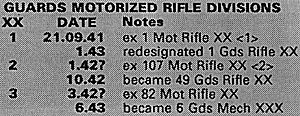 Guards Motorized Rifle
Divisions Notes:
Guards Motorized Rifle
Divisions Notes:
1) The 1 Mot Rifle XX was one of the showcase divisions of the Soviet Army. Originally the 1st Moskva Proletariat Rifle Division in 1939, it became the 1st Moskva Proletariat Motorized Rifle Division in 1940, but it actually went to the organization of a motorized division, not a motorized rifle division. On 22 June 1941, it was part of 7th Mechanized Corps and had 255 tanks, including 30 T-34s.
It was detached from the Corps (and I think, had its T-34s removed) and sent to the front, where it fought with skill. In August it was renamed the 1st Tank Division, before becoming the 1st Guards Motorized Rifle Division in September.
2) Don't bother looking for a 107 Mot Rifle XX in your Scorched Earth OB. This unit is actually the 107 Tank XX, which the Soviets raised and sent to the front as such. At the front, it lost most or all of its 200 tanks, so the Soviets decided to call it a motorized rifle division.
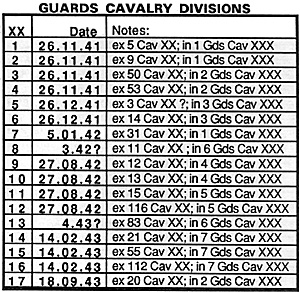 CAVALRY DIVISIONS
CAVALRY DIVISIONS
The Soviet Union, and Russia before it, had a tradition of excellent cavalry, which continued in World War II. The Soviets had a variety of cavalry organizations, from mixes of cavalry and tank regiments to mountain cavalry to light divisions. As with other arms, the best cavalry divisions became Guards.
Correction (from Europa 13)
Page 21: 5th Gds Cav XX was formed from 3rd Cav XX
More Soviet Guards: Part II
Soviet Guards Airborne Brigades Errata [Europa Issue 21]
More WWII Soviet Guard Units: Part I
Back to Europa Number 12 Table of Contents
Back to Europa List of Issues
Back to MagWeb Master Magazine List
© Copyright 1990 by GR/D
This article appears in MagWeb (Magazine Web) on the Internet World Wide Web. Other military history articles and gaming articles are available at http://www.magweb.com